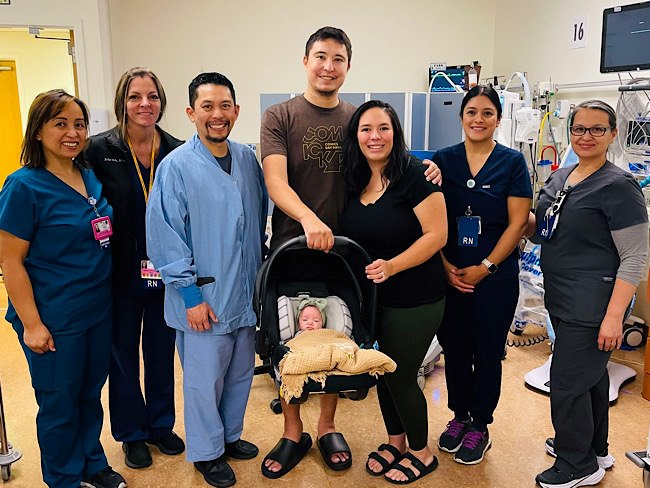Trial compares two gestational diabetes screening methods
Kaiser Permanente researchers conducted a large-scale randomized trial involving nearly 24,000 women and found no difference in health outcomes.
PRESS RELEASE
Contact: John Ogden
john.r.ogden@kpchr.org
503-610-5726
Kerry Sinclair
ksinclair@webershandwick.com
310-710-0321
PORTLAND, Oregon — There were no significant differences in health outcomes for pregnant women who were diagnosed with gestational diabetes or their babies using two different clinically recommended screening methods, according to results from a large-scale clinical trial conducted by Kaiser Permanente researchers and published in The New England Journal of Medicine.
Although there is evidence that treating pregnant women for gestational diabetes leads to improved health outcomes for mothers and their infants, there is no scientific consensus on how best to screen for gestational diabetes. Two different approaches are recommended and used in clinical practice in the United States: a 1-step protocol that requires women to fast prior to the test (currently preferred by the American Diabetes Association) and a 2-step approach that does not require fasting for the initial test (currently recommended by the American College of Obstetricians and Gynecologists). This study was the first head-to-head trial comparing maternal and perinatal outcomes of the two methods.
“We know that screening and diagnosing women with gestational diabetes improves outcomes for mothers and babies,” said lead author Teresa Hillier, MD, MS, investigator at the Kaiser Permanente Northwest Center for Health Research and Kaiser Permanente Hawaii Center for Integrated Health Care Research. “Our trial was designed to determine whether there were any differences in outcomes between the two approaches. The one-step method diagnoses twice as many women, typically leading to treatment of women with milder gestational diabetes, but we found no evidence that this higher diagnosis rate led to differences in outcomes.”
The study involved nearly 24,000 pregnant women from Kaiser Permanente in Hawaii and from the Northwest in Portland, Oregon, all of whom were randomly assigned to the 1-step or the 2-step testing protocol to screen for gestational diabetes as part of their clinical care. This head-to-head study design compared outcomes across the entire population in a “real-world” clinical setting, allowing generalizability to everyday clinical practice. The women were enrolled between May 28, 2014, and December 31, 2017, and data on outcomes were collected between 2014 through 2018. The outcomes evaluated included rates of gestational diabetes diagnosis, large-for-gestational-age infants, gestational hypertension or preeclampsia, primary cesarean section, and a composite measure of several adverse perinatal outcomes that included stillbirth and neonatal death.
The study found:
- Among the 94% of women who completed screening, a larger share (92%) of women randomized into the 2-step protocol were adherent than those randomized into the 1-step approach (66%).
- There was a significant difference in diagnosis of gestational diabetes; 16.5% of women were diagnosed in the 1-step approach compared to 8.5% in the 2-step protocol.
- There were no significant differences between the two gestational diabetes screening approaches in the primary maternal or perinatal health outcomes.
- Rates were also similar between groups across a range of secondary and safety outcomes, including preterm birth and admission to neonatal intensive care.
“What this large-scale clinical trial illustrates is that the 2-step screening method appears to be preferred by patients and providers, and had a lower screen-positive rate, and led to outcomes that were not different from the 1-step method,” explained Keith Ogasawara, MD, chief perinatologist, Department of Obstetrics and Gynecology with Kaiser Permanente in Hawaii.
The study was funded by the Eunice Kennedy Shriver National Institute of Child Health and Human Development.
Other authors on the study include Kathryn Pedula, MS, Hawaii Permanente Medical Group, Honolulu; Kimberly K. Vesco, MD, MPH, Kaiser Permanente Center for Health Research, Portland, Oregon; Caryn E. S. Oshiro, PhD, Kaiser Permanente Center for Integrated Health Care Research, Honolulu; Suzanne Lubarsky, MD, Northwest Permanente, Portland; and Jan Van Marter, MPA, RN, Kaiser Permanente Center for Health Research, Portland.
About Kaiser Permanente
Kaiser Permanente is committed to helping shape the future of health care. We are recognized as one of America’s leading health care providers and not-for-profit health plans. Founded in 1945, Kaiser Permanente has a mission to provide high-quality, affordable health care services and to improve the health of our members and the communities we serve. We currently serve 12.4 million members in 8 states and the District of Columbia. Care for members and patients is focused on their total health and guided by their personal Permanente Medical Group physicians, specialists, and team of caregivers. Our expert and caring medical teams are empowered and supported by industry-leading technology advances and tools for health promotion, disease prevention, state-of-the-art care delivery, and world-class chronic disease management. Kaiser Permanente is dedicated to care innovations, clinical research, health education, and the support of community health.























































